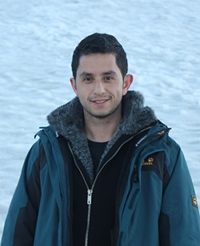GFI/BCCR Seminar: Permafrost Carbon-Climate Feedbacks and Uncertainties in Earth System Models
Main content
Altug Ekici (Uni Research Klima)
Permafrost Carbon-Climate Feedbacks and Uncertainties in Earth System Models
Abstract
Climate change induced thawing of frozen soils give way to the potential release of huge carbon stocks within the permafrost regions. This can prominently affect the future atmospheric CO2 pathways and the estimates of such alterations are widely uncertain. To constrain this effect, the land surface models JULES and ORCHIDEE, each with a revised representation of permafrost carbon, were coupled to the IMOGEN intermediate complexity climate and ocean carbon uptake model. IMOGEN calculates atmospheric carbon dioxide (CO2) and local monthly surface climate for a given emission scenario with the land-atmosphere CO2 flux exchange from either JULES or ORCHIDEE. These simulations include feedbacks associated with permafrost carbon changes in a warming world. Both IMOGEN-JULES andIMOGEN-ORCHIDEE were forced by historical and three alternative future CO2 emission scenarios. Simulations were performed for different climate sensitivities and regional climate change patterns based on 22 different Earth System Models (ESM) used for CMIP3 (phase 3 of the Coupled Model Intercomparison Project), allowing us to explore climate uncertainties in the context of permafrost carbon – climate feedbacks. Three future emission scenarios consistent with three representative concentration pathways: RCP2.6; RCP4.5 and RCP8.5 were used. Paired simulations with and without frozen carbon processes were required to quantify the impact of the permafrost carbon feedback on climate change. The additional warming from the permafrost carbon feedback is between 0.2 and 12 % of the change in the global mean temperature (ΔT) by year 2100 and 0.5 and 17 % of ΔT by 2300, this range reflecting differences in land surface models, climate models and emissions pathway. As a percentage of ΔT, the permafrost carbon feedback has a greater impact on the low emission scenario (RCP2.6) than on the higher emissions scenarios suggesting that permafrost carbon should be taken into account when evaluating heavy mitigation and stabilizations scenarios. Structural differences between the land surface models are found to be a larger source of uncertainties than differences between climate models, in particular due to different representations of soil carbon decomposition. Inertia in the permafrost carbon system means that the permafrost carbon response is dependent on the temporal trajectory of warming as well as the absolute amount of warming. We propose a new policy relevant metric - the Frozen Carbon Vulnerability timescale (FCVt) in years - that can be derived from the more complex land surface models and used to quantify the permafrost carbon response given any pathway of global temperature change.
